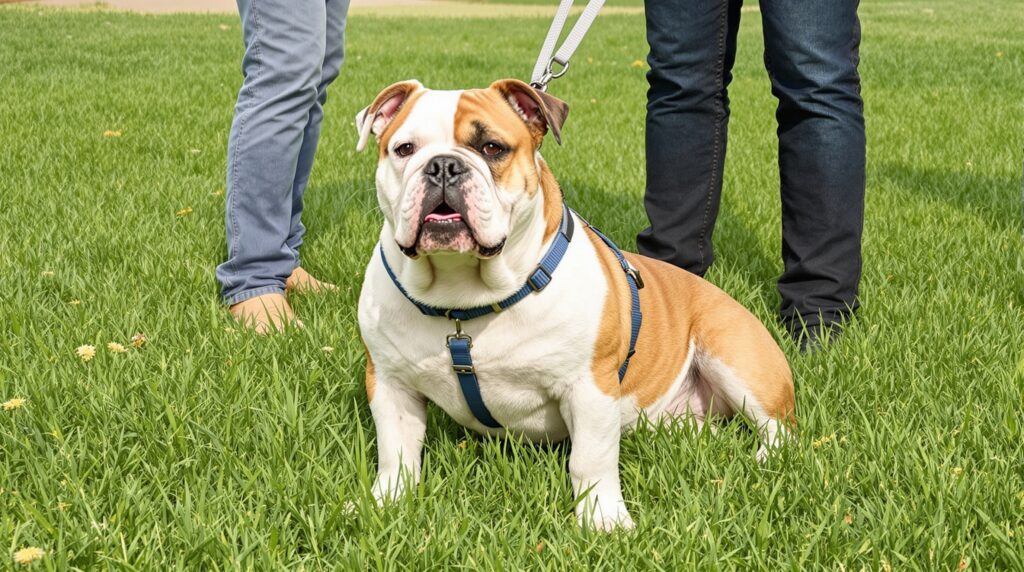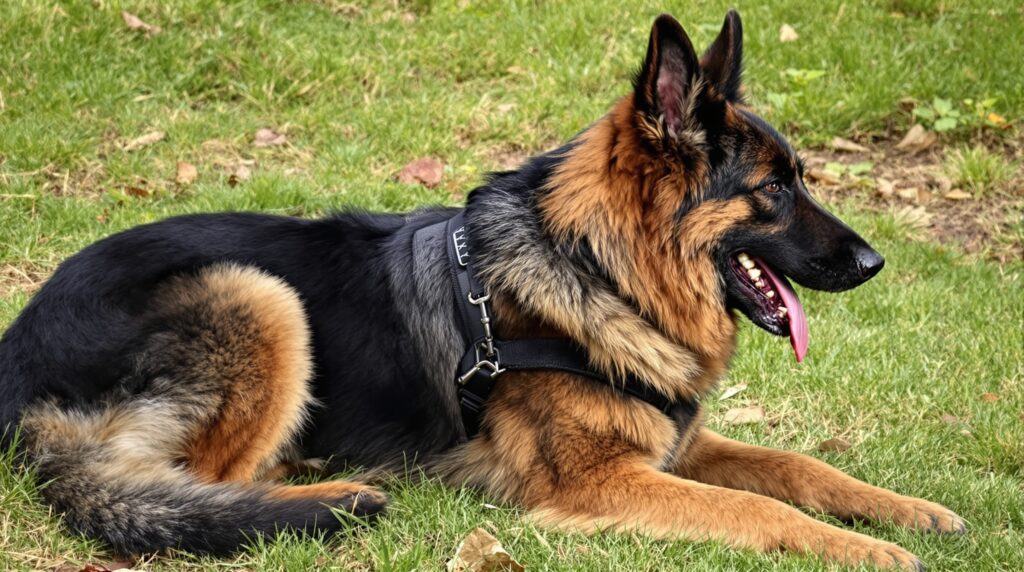Rottweilers grow into strong, loyal, and protective dogs. Their behavior as adults often depends on the experiences they have as puppies.
Early socialization helps them build confidence, reduce fear, and develop into well-mannered companions. When you start at the right age, guiding them through new situations gets a whole lot easier.
This article digs into simple steps that matter most during those first weeks. Meeting new people, exploring different environments, and learning to stay calm around sounds and animals—each step shapes a balanced, friendly Rottweiler.
Start socialization between 3 and 16 weeks old
The best time for a Rottweiler puppy to start socialization is between 3 and 16 weeks old. During this stage, puppies are more open to new sights and sounds.
They learn quickly and build confidence easier than at later ages. Breeders or foster homes usually handle the first few weeks, making sure puppies get gentle human contact and time with littermates.
Once the puppy joins a new family, owners should keep up with regular, positive exposure to people, places, and safe situations. Puppies are less cautious and more curious at this age, so meeting different people and exploring varied environments really helps.
If you start socialization after this window, progress moves slower. Puppies still learn, but it takes more patience and consistency.
Introduce your puppy to different people daily
Meeting new people helps a Rottweiler puppy feel safe and relaxed around strangers. Daily introductions give them practice in reading body language and adjusting to different voices.
They should meet people of different ages, sizes, and appearances. This variety helps the puppy learn that people can look and act differently but still be safe.
Short, calm visits work best. Never force a puppy to interact—let them approach at their own pace.
Encourage visitors to offer gentle pets or treats when the puppy shows interest. Positive experiences build trust and reduce the chance of fear later.
Frequent exposure also teaches the puppy not to rely too much on one person. Letting them greet neighbors, meet delivery workers, or say hello to friends all adds up.
Over time, these small moments shape a confident and friendly adult dog.
Expose your Rottweiler to various environments
A young Rottweiler needs to see more than just the home and backyard. Taking them to different places helps them adjust to new sights, sounds, and smells without getting nervous.
Visit quiet streets, busy sidewalks, or open parks. Each setting gives them a chance to practice calm behavior and feel comfortable.
Introduce them to different surfaces, like grass, gravel, or pavement. These small experiences teach the puppy that change is normal and nothing to worry about.
Short, positive trips work best. A walk through a dog-friendly store or sitting at an outdoor café can be great exposure.
The goal isn’t to overwhelm. It’s about creating steady, positive associations.
Gently socialize with other vaccinated dogs

Young Rottweilers really benefit from calm, safe meetings with other dogs. These early experiences help them learn polite behavior and lower their fear around new canine friends.
Choose dogs that are healthy, friendly, and fully vaccinated. This keeps things safe and positive for everyone.
Short play sessions work best at first. Keeping the time brief prevents overstimulation and helps the puppy feel secure.
Watch body language closely. If your puppy looks nervous or overwhelmed, pause and try again later.
Meeting dogs of different ages, sizes, and temperaments helps the Rottweiler adjust to a variety of social situations. Structured settings, like puppy classes or supervised playdates, provide a controlled space for practice.
With patience and consistency, gentle socialization with vaccinated dogs lays the foundation for a confident adult Rottweiler.
Use positive reinforcement during new experiences
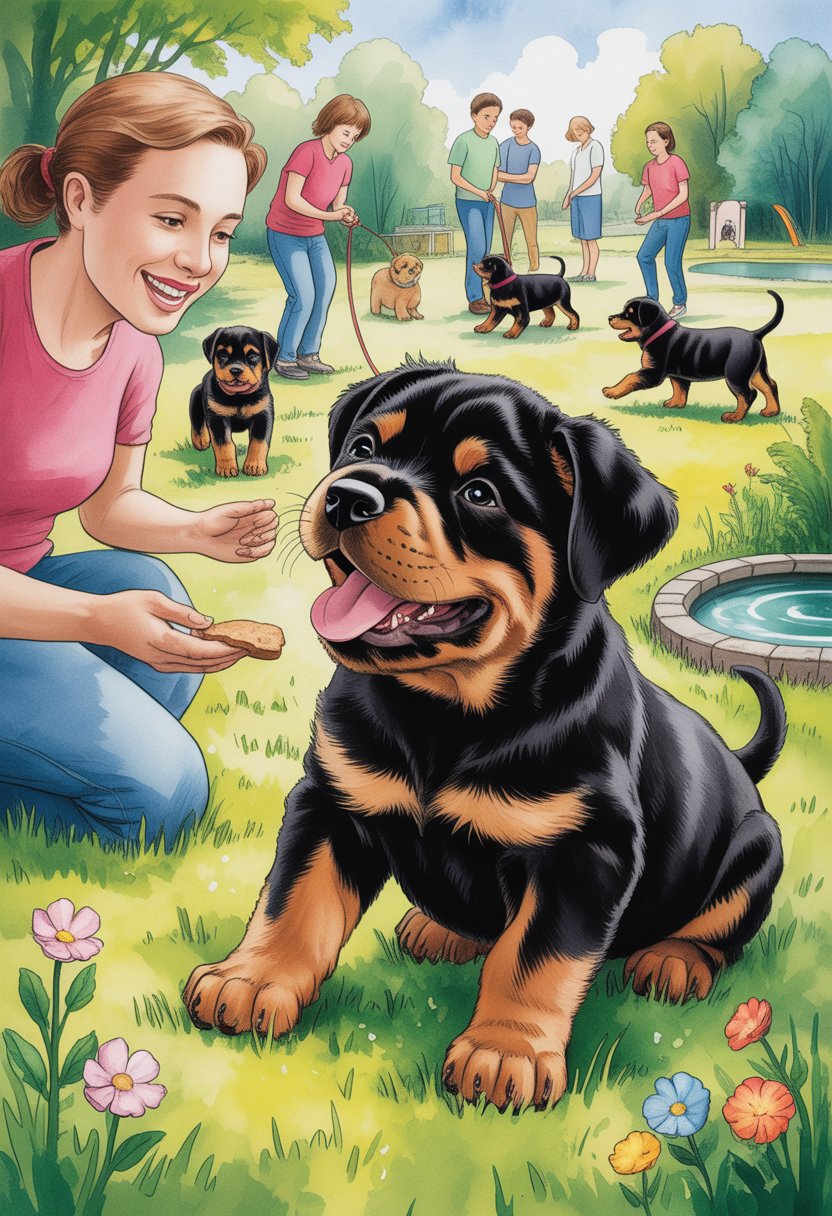
When a Rottweiler meets new people, animals, or environments, positive reinforcement helps them feel safe and confident. Rewarding calm behavior with treats, praise, or play teaches them that new situations bring good things.
They learn faster when rewards come right after the behavior. A gentle pat or a small treat can make the experience enjoyable.
Using rewards also builds trust between the dog and the owner. The Rottweiler starts to see their handler as a source of safety during unfamiliar moments.
If your dog seems hesitant, keep the experience short and reward even small steps forward. That steady approach helps prevent fear or resistance from taking root.
Consistency matters. By rewarding positive behavior every time, you help your Rottweiler form habits that last.
Handle your puppy often to build trust
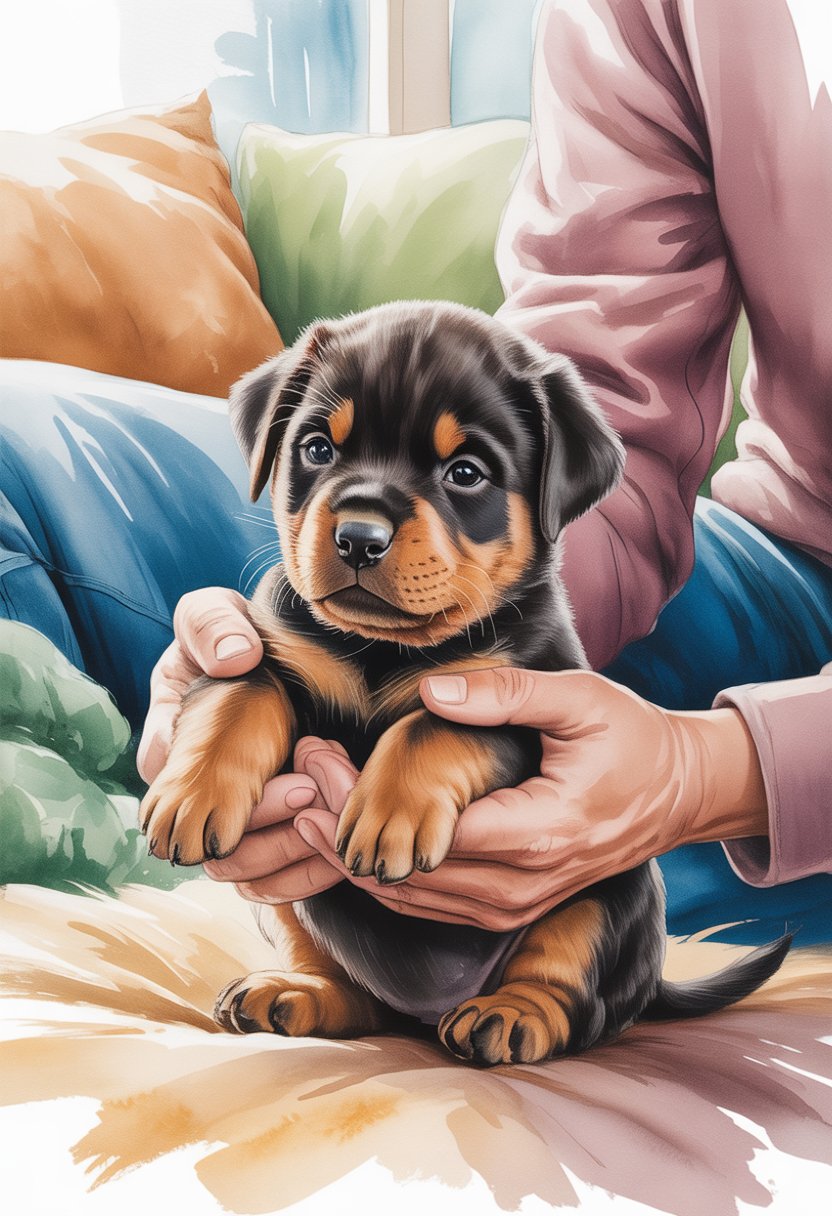
Regular handling helps a Rottweiler puppy learn that human touch is safe and normal. When they’re comfortable being touched, they’re less likely to resist grooming, vet visits, or daily care.
Gently touch your puppy’s paws, ears, and mouth during calm moments. Keep sessions short, and stop before the puppy gets restless.
A calm voice and gentle strokes help the puppy relax. Offering a small treat after handling can also create a positive link between touch and reward.
Frequent, gentle contact builds trust and strengthens the bond between puppy and owner. With time, handling just becomes part of normal life.
Introduce sounds like traffic and household noises
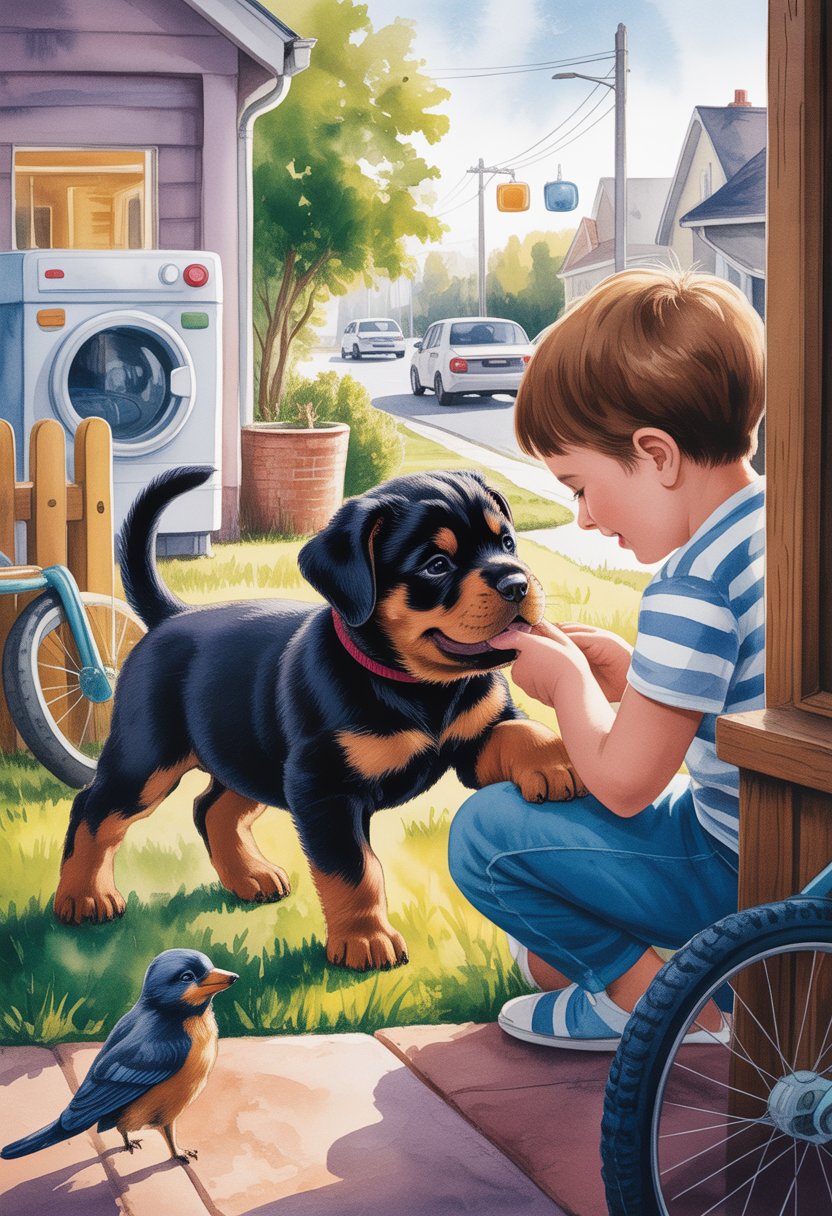
A Rottweiler puppy needs to get used to everyday sounds early on. Household noises like the vacuum, dishwasher, or doorbell can seem scary if you don’t introduce them calmly.
Start with softer sounds so the puppy feels safe. Once they’re comfortable indoors, let them hear outdoor sounds too.
Traffic, kids playing, or dogs barking nearby are common noises they’ll face. Short, positive exposures keep fear from building up.
Pair these sounds with something pleasant, like treats or playtime. Over time, they’ll learn that noises are just part of life.
Introducing sounds in small steps works best. A sudden loud noise can overwhelm a young puppy, so steady and gentle exposure is the way to go.
Take short car rides to reduce travel anxiety
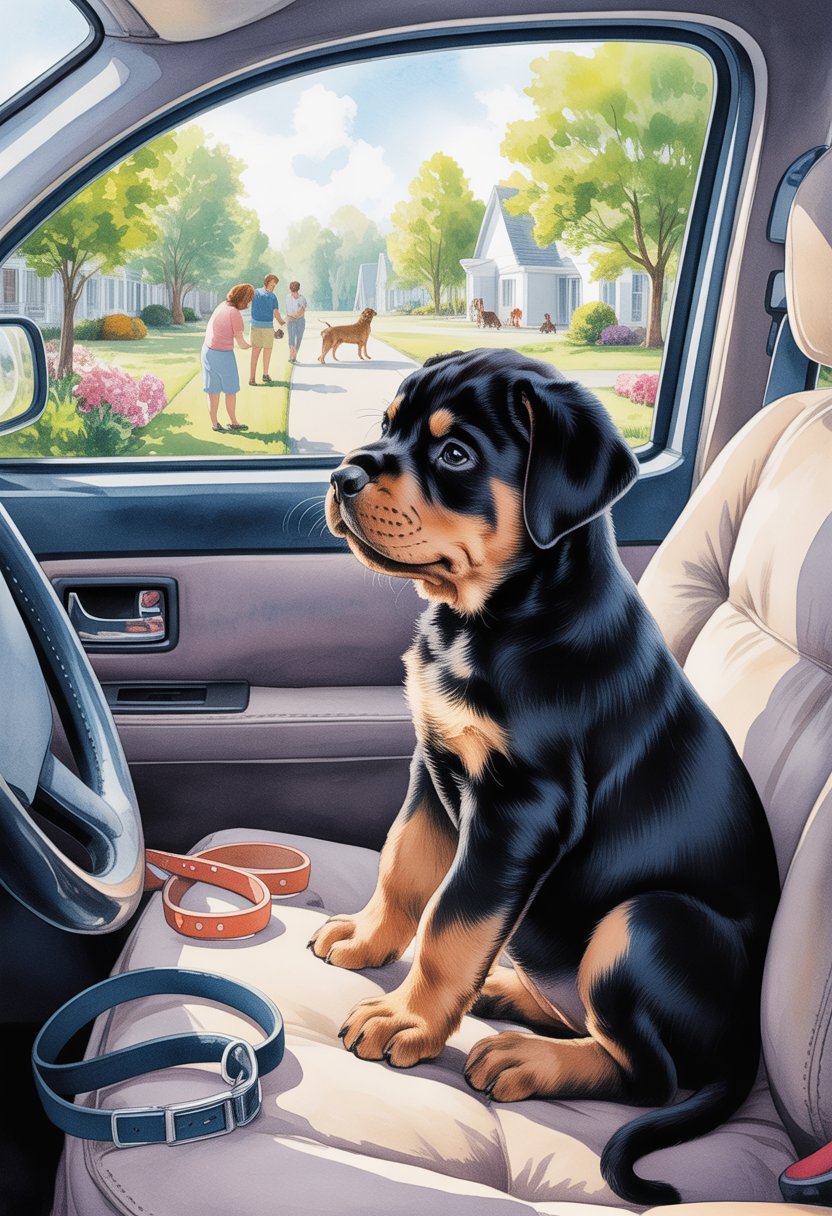
Rottweiler puppies benefit from early exposure to car rides. Short, calm trips help them get used to the sights, sounds, and motion of cars without getting overwhelmed.
Start by letting the puppy sit in the parked car for a few minutes. This gives them a chance to explore and feel safe before the engine starts.
Once your puppy seems relaxed, try short drives around the block. Keep rides brief and positive, and bring a favorite toy or blanket for comfort.
As the puppy adjusts, you can slowly increase the length of trips. Patience and consistency matter here, and always reward calm behavior.
Enroll in a puppy socialization class
A puppy socialization class gives young Rottweilers a safe place to meet other dogs and people. These classes help puppies build confidence and learn how to behave in new situations.
Trained instructors guide the sessions so puppies can interact in a controlled way. This lowers the chance of overwhelming or scary experiences.
Most experts say to start before three months of age, since puppies are more open to new sights and sounds then. Classes also support early training, letting puppies practice simple commands around distractions.
Attending weekly classes gives puppies regular exposure to different people, voices, and movements. For Rottweilers, who grow into strong protectors, these early lessons are especially valuable.
Learning to stay relaxed around strangers and other pets can prevent behavior problems down the road.
Understanding the Importance of Early Socialization
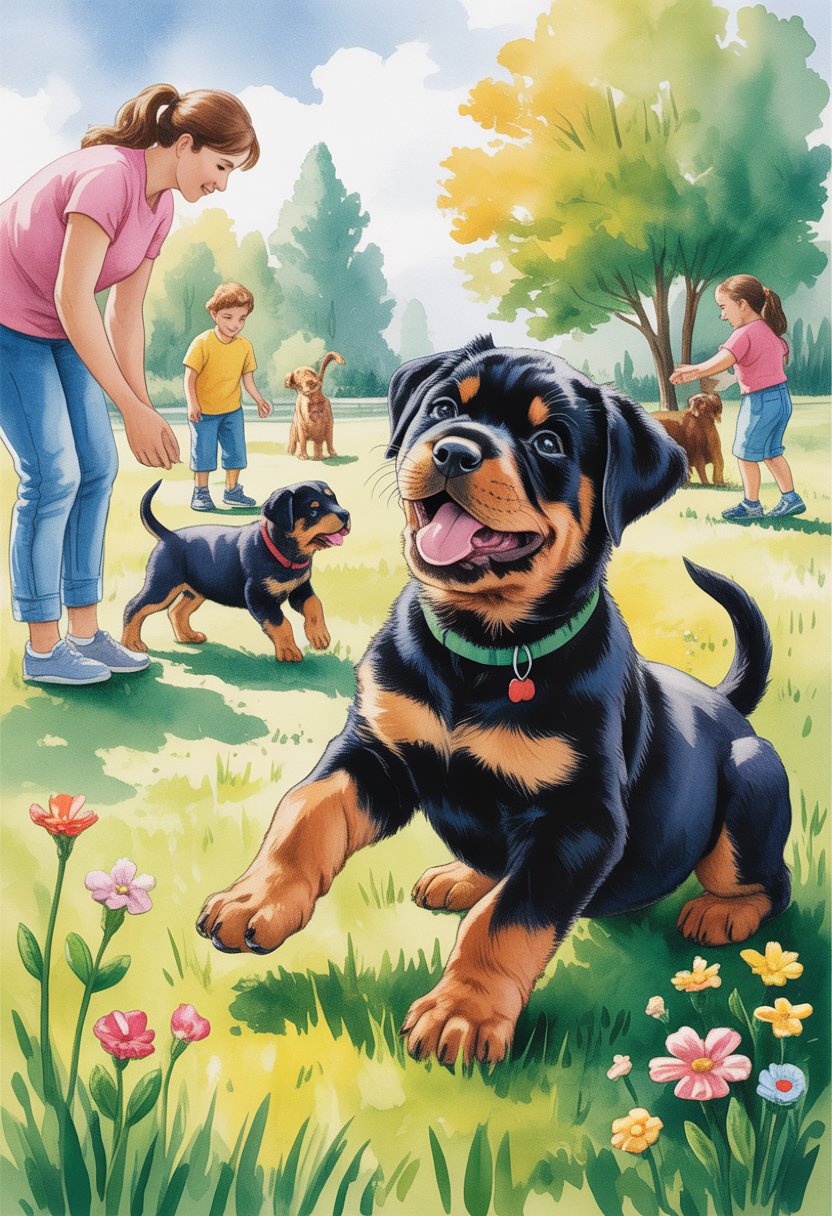
Early socialization gives a Rottweiler the tools to handle new people, animals, and environments with confidence. It cuts down on fear-based reactions and helps prevent unwanted behaviors later in life.
How Socialization Shapes Rottweiler Temperament
A Rottweiler’s temperament isn’t set in stone from birth. What happens in those first few months really shapes how the dog reacts to the world.
Meeting lots of people, hearing weird new sounds, and exploring safe places all help build calm, balanced behavior. Without these early lessons, even a confident puppy might get jumpy or unsure when facing something unfamiliar.
Owners who gently guide their dogs through positive encounters teach them trust and adaptability. Socialization also helps channel natural traits like loyalty and protectiveness in the right direction.
When you shape these instincts early, you get a dog who’s steady and reliable, not jumpy or suspicious.
Practical steps? Try these:
- Introduce friendly dogs in controlled settings
- Expose to daily noises like vacuums or traffic
- Meet people of all ages in safe situations
Common Challenges Without Proper Socialization
If a Rottweiler misses out on early socialization, you’ll probably notice fear or aggression pop up. Some bark too much at strangers, act nervous around kids, or just refuse new environments altogether.
Stuff like vet visits or simple walks can turn into a hassle. Unfamiliar situations often trigger defensive reactions.
For example, a dog that’s never met other animals might lunge or growl when introduced. That’s not “bad temperament”—it’s just that nobody taught the dog how to stay calm.
Training gets harder, too. A poorly socialized Rottweiler often struggles to focus, which makes obedience a pain. These problems can strain the bond between dog and family.
Building Positive Experiences for Your Rottweiler
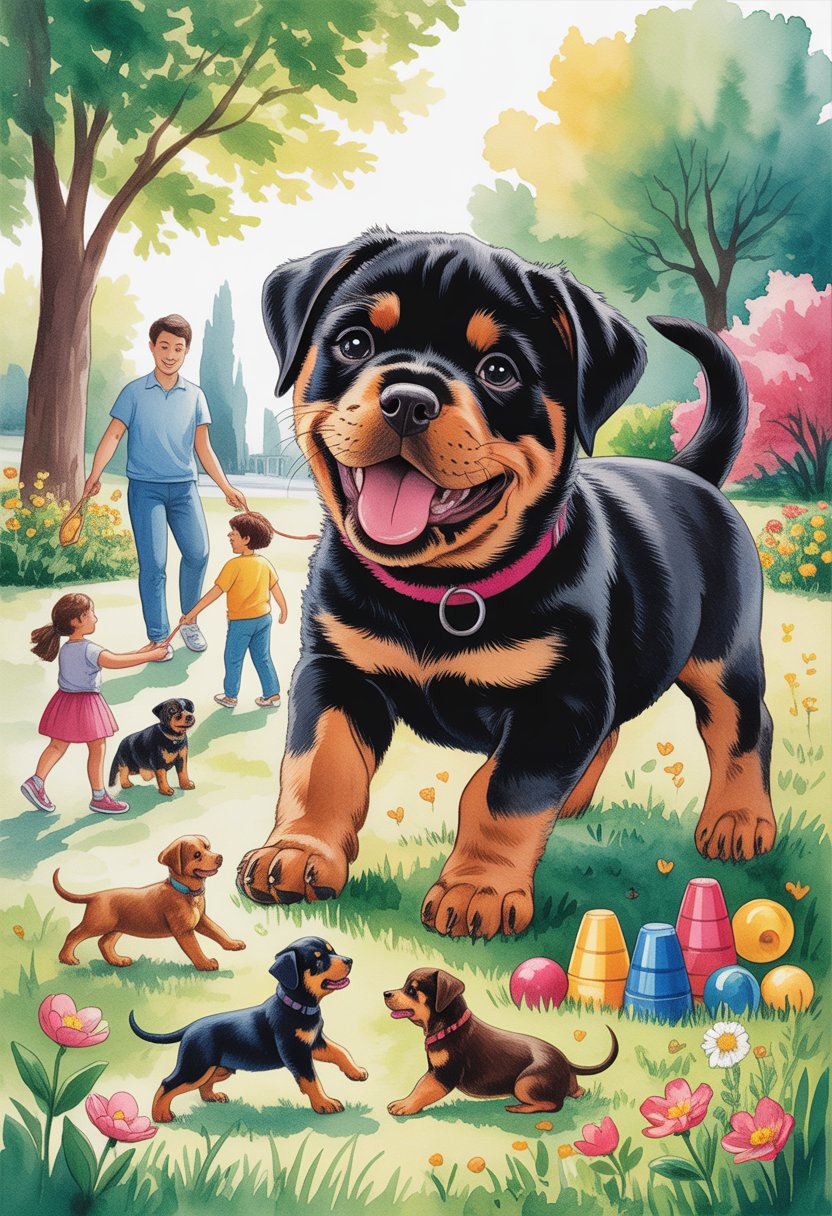
A young Rottweiler really learns best when new situations feel safe and rewarding. Positive exposure to people, places, and sounds helps reduce fear and builds real confidence.
Choosing Safe Socialization Environments
Pick calm, low-stress places for those first outings. Busy areas with loud noises or off-leash dogs can overwhelm a puppy fast.
Safer bets are quiet parks, pet-friendly stores, or visits with friends who have gentle dogs. Start small—maybe a short walk around the block or just hanging out on the porch.
That way, your puppy gets new sights and sounds without too much pressure. Sessions should stay short and end on a good note.
Here’s a simple checklist for safe choices:
- Controlled setting: somewhere predictable, not chaotic
- Healthy dogs: vaccinated, friendly companions only
- Supportive people: calm folks who know how to give space
- Gradual exposure: slowly add in more noise, crowds, or activity
By choosing environments carefully, you help your Rottweiler link new experiences with safety and trust. Isn’t that what we all want for our dogs?
Recognizing Signs of Progress
You’ll know you’re getting somewhere when your puppy seems curious instead of scared. A loose, wiggly body, wagging tail, and a little bit of exploring—those are all clear signs of comfort.
But if you see a tucked tail, stiff body, or hiding, it probably means you need to slow things down. Sometimes it’s easy to miss these details, so paying attention really matters.
Jotting down small wins can help you see growth over time. The first calm greeting with a stranger or ignoring a loud noise without freaking out? That’s real progress.
Keeping a simple log makes it easier to spot changes:
| Situation | Puppy’s Response | Next Step |
|---|---|---|
| Meeting new person | Sniffed calmly | Add gentle petting |
| Hearing vacuum | Looked, then relaxed | Keep exposure short |
When you notice these little shifts, you can tweak your pace. Every step should feel like a win for both of you.


